Fumarate reductase activity maintains an energized membrane in anaerobic Mycobacterium tuberculosis
- PMID: 21998585
- PMCID: PMC3188519
- DOI: 10.1371/journal.ppat.1002287
Fumarate reductase activity maintains an energized membrane in anaerobic Mycobacterium tuberculosis
Abstract
Oxygen depletion of Mycobacterium tuberculosis engages the DosR regulon that coordinates an overall down-regulation of metabolism while up-regulating specific genes involved in respiration and central metabolism. We have developed a chemostat model of M. tuberculosis where growth rate was a function of dissolved oxygen concentration to analyze metabolic adaptation to hypoxia. A drop in dissolved oxygen concentration from 50 mmHg to 0.42 mmHg led to a 2.3 fold decrease in intracellular ATP levels with an almost 70-fold increase in the ratio of NADH/NAD(+). This suggests that re-oxidation of this co-factor becomes limiting in the absence of a terminal electron acceptor. Upon oxygen limitation genes involved in the reverse TCA cycle were upregulated and this upregulation was associated with a significant accumulation of succinate in the extracellular milieu. We confirmed that this succinate was produced by a reversal of the TCA cycle towards the non-oxidative direction with net CO(2) incorporation by analysis of the isotopomers of secreted succinate after feeding stable isotope ((13)C) labeled precursors. This showed that the resulting succinate retained both carbons lost during oxidative operation of the TCA cycle. Metabolomic analyses of all glycolytic and TCA cycle intermediates from (13)C-glucose fed cells under aerobic and anaerobic conditions showed a clear reversal of isotope labeling patterns accompanying the switch from normoxic to anoxic conditions. M. tuberculosis encodes three potential succinate-producing enzymes including a canonical fumarate reductase which was highly upregulated under hypoxia. Knockout of frd, however, failed to reduce succinate accumulation and gene expression studies revealed a compensatory upregulation of two homologous enzymes. These major realignments of central metabolism are consistent with a model of oxygen-induced stasis in which an energized membrane is maintained by coupling the reductive branch of the TCA cycle to succinate secretion. This fermentative process may offer unique targets for the treatment of latent tuberculosis.
Conflict of interest statement
The authors have declared that no competing interests exist.
Figures
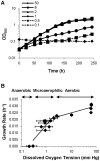

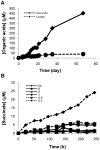
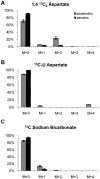

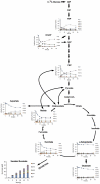
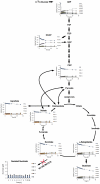


Similar articles
-
The dual-functioning fumarate reductase is the sole succinate:quinone reductase in Campylobacter jejuni and is required for full host colonization.J Bacteriol. 2009 Aug;191(16):5293-300. doi: 10.1128/JB.00166-09. Epub 2009 Jun 12. J Bacteriol. 2009. PMID: 19525346 Free PMC article.
-
Impaired Succinate Oxidation Prevents Growth and Influences Drug Susceptibility in Mycobacterium tuberculosis.mBio. 2022 Aug 30;13(4):e0167222. doi: 10.1128/mbio.01672-22. Epub 2022 Jul 20. mBio. 2022. PMID: 35856639 Free PMC article.
-
Succinate dehydrogenase is the regulator of respiration in Mycobacterium tuberculosis.PLoS Pathog. 2014 Nov 20;10(11):e1004510. doi: 10.1371/journal.ppat.1004510. eCollection 2014 Nov. PLoS Pathog. 2014. PMID: 25412183 Free PMC article.
-
Succinate in ischemia: Where does it come from?Int J Biochem Cell Biol. 2019 Oct;115:105580. doi: 10.1016/j.biocel.2019.105580. Epub 2019 Aug 5. Int J Biochem Cell Biol. 2019. PMID: 31394174 Review.
-
Succinate:quinone oxidoreductases from epsilon-proteobacteria.Biochim Biophys Acta. 2002 Jan 17;1553(1-2):84-101. doi: 10.1016/s0005-2728(01)00230-4. Biochim Biophys Acta. 2002. PMID: 11803019 Review.
Cited by
-
Transcriptional and Physiological Changes during Mycobacterium tuberculosis Reactivation from Non-replicating Persistence.Front Microbiol. 2016 Aug 31;7:1346. doi: 10.3389/fmicb.2016.01346. eCollection 2016. Front Microbiol. 2016. PMID: 27630619 Free PMC article.
-
The Sculpting of the Mycobacterium tuberculosis Genome by Host Cell-Derived Pressures.Microbiol Spectr. 2014 Oct;2(5):10.1128/microbiolspec.MGM2-0016-2013. doi: 10.1128/microbiolspec.MGM2-0016-2013. Microbiol Spectr. 2014. PMID: 25584198 Free PMC article. Review.
-
Modeling phenotypic metabolic adaptations of Mycobacterium tuberculosis H37Rv under hypoxia.PLoS Comput Biol. 2012;8(9):e1002688. doi: 10.1371/journal.pcbi.1002688. Epub 2012 Sep 13. PLoS Comput Biol. 2012. PMID: 23028286 Free PMC article.
-
Mycobacterial genes essential for the pathogen's survival in the host.Immunol Rev. 2015 Mar;264(1):319-26. doi: 10.1111/imr.12256. Immunol Rev. 2015. PMID: 25703569 Free PMC article. Review.
-
SAR study of piperidine derivatives as inhibitors of 1,4-dihydroxy-2-naphthoate isoprenyltransferase (MenA) from Mycobacterium tuberculosis.Eur J Med Chem. 2023 Mar 5;249:115125. doi: 10.1016/j.ejmech.2023.115125. Epub 2023 Jan 18. Eur J Med Chem. 2023. PMID: 36682292 Free PMC article.
References
-
- Corbett EL, Watt CJ, Walker N, Maher D, Williams BG, et al. The growing burden of tuberculosis: global trends and interactions with the HIV epidemic. Arch Intern Med. 2003;163:1009–1021. - PubMed
-
- Boshoff HI, Barry CE., Iii Is the mycobacterial cell wall a hopeless drug target for latent tuberculosis? Drug Discovery Today: Disease Mechanisms. 2006;3:237–245.
-
- Targeted tuberculin testing and treatment of latent tuberculosis infection. American Thoracic Society. MMWR Recomm Rep. 2000;49:1–51. - PubMed
-
- Lee SW, Jang YS, Park CM, Kang HY, Koh WJ, et al. The role of chest CT scanning in TB outbreak investigation. Chest. 2010;137:1057–1064. - PubMed
Publication types
MeSH terms
Substances
Grants and funding
LinkOut - more resources
Full Text Sources
Other Literature Sources
Molecular Biology Databases

